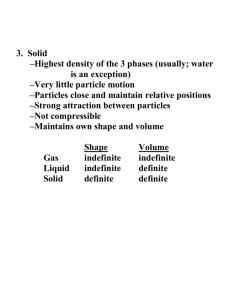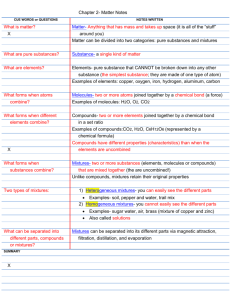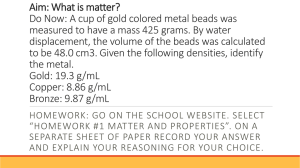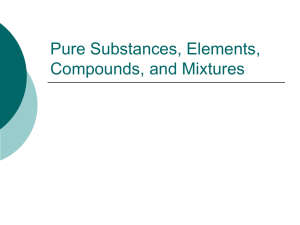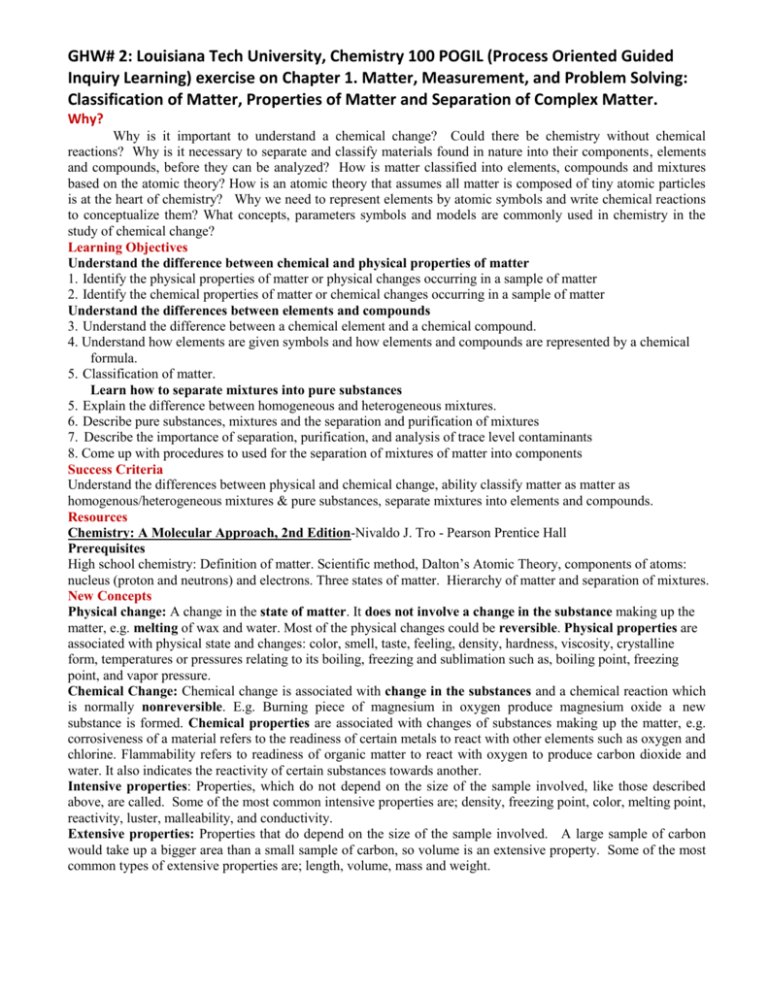
GHW# 2: Louisiana Tech University, Chemistry 100 POGIL (Process Oriented Guided
Inquiry Learning) exercise on Chapter 1. Matter, Measurement, and Problem Solving:
Classification of Matter, Properties of Matter and Separation of Complex Matter.
Why?
Why is it important to understand a chemical change? Could there be chemistry without chemical
reactions? Why is it necessary to separate and classify materials found in nature into their components, elements
and compounds, before they can be analyzed? How is matter classified into elements, compounds and mixtures
based on the atomic theory? How is an atomic theory that assumes all matter is composed of tiny atomic particles
is at the heart of chemistry? Why we need to represent elements by atomic symbols and write chemical reactions
to conceptualize them? What concepts, parameters symbols and models are commonly used in chemistry in the
study of chemical change?
Learning Objectives
Understand the difference between chemical and physical properties of matter
1. Identify the physical properties of matter or physical changes occurring in a sample of matter
2. Identify the chemical properties of matter or chemical changes occurring in a sample of matter
Understand the differences between elements and compounds
3. Understand the difference between a chemical element and a chemical compound.
4. Understand how elements are given symbols and how elements and compounds are represented by a chemical
formula.
5. Classification of matter.
Learn how to separate mixtures into pure substances
5. Explain the difference between homogeneous and heterogeneous mixtures.
6. Describe pure substances, mixtures and the separation and purification of mixtures
7. Describe the importance of separation, purification, and analysis of trace level contaminants
8. Come up with procedures to used for the separation of mixtures of matter into components
Success Criteria
Understand the differences between physical and chemical change, ability classify matter as matter as
homogenous/heterogeneous mixtures & pure substances, separate mixtures into elements and compounds.
Resources
Chemistry: A Molecular Approach, 2nd Edition-Nivaldo J. Tro - Pearson Prentice Hall
Prerequisites
High school chemistry: Definition of matter. Scientific method, Dalton’s Atomic Theory, components of atoms:
nucleus (proton and neutrons) and electrons. Three states of matter. Hierarchy of matter and separation of mixtures.
New Concepts
Physical change: A change in the state of matter. It does not involve a change in the substance making up the
matter, e.g. melting of wax and water. Most of the physical changes could be reversible. Physical properties are
associated with physical state and changes: color, smell, taste, feeling, density, hardness, viscosity, crystalline
form, temperatures or pressures relating to its boiling, freezing and sublimation such as, boiling point, freezing
point, and vapor pressure.
Chemical Change: Chemical change is associated with change in the substances and a chemical reaction which
is normally nonreversible. E.g. Burning piece of magnesium in oxygen produce magnesium oxide a new
substance is formed. Chemical properties are associated with changes of substances making up the matter, e.g.
corrosiveness of a material refers to the readiness of certain metals to react with other elements such as oxygen and
chlorine. Flammability refers to readiness of organic matter to react with oxygen to produce carbon dioxide and
water. It also indicates the reactivity of certain substances towards another.
Intensive properties: Properties, which do not depend on the size of the sample involved, like those described
above, are called. Some of the most common intensive properties are; density, freezing point, color, melting point,
reactivity, luster, malleability, and conductivity.
Extensive properties: Properties that do depend on the size of the sample involved. A large sample of carbon
would take up a bigger area than a small sample of carbon, so volume is an extensive property. Some of the most
common types of extensive properties are; length, volume, mass and weight.
How are elements given symbols?
Chemical symbols use letters in the element name can be one or two letters. The first letter is always a
capital case and the second letter is always a small case. Some symbols are taken from the Latin or
German names of the elements:
Na = sodium (Natrium), K = potassium (Kalium), Fe = iron (Ferrum), Cu = copper(Cuprum), Ag =
silver(Argentum), Sn = tin(Stannum), Sb = antimony (Stibium), W = tungsten(Wolfram), Au = gold, Hg
= mercury(Hydrargyrum), Pb = lead (Plumbum)
What is an allotrope of an element? An element that can exist in two or more forms is said to have allotropes.
E.g. amorphous carbon, graphite, diamond, carbon Buckey-balls, carbon nano-tubes.
GHW#2 Name: ______________________ Date submitted:________ Group Name:______
Key Questions (relatively simple to answers using the Focus Information)
1) Describe the classification of matter based on state of matter and composition.
2) What is a pure substance? (Describe it generally and given two examples)
3) What is a chemical element? (Describe it generally and given an example)
4) What is an allotrope of an element? (Describe it generally and given an example)
5) What is a chemical compound? (Describe it generally and given an example)
6) What properties are used to separate mixtures into pure substances?
7) How are the elements given symbols? (Give three examples)
8) How are the compounds given formulas? (Give three examples)
Physical and Chemical Changes and Physical and Chemical Properties
9) What is a physical change? Describe it generally and given an example.
10) What is a chemical change? Describe it generally and given an example.
11) List physical properties: Describe it generally and given an example.
a)
b)
c)
d)
e)
12) List chemical properties: name them and given an example.
a)
b)
c)
d)
13) What is the difference between intensive and extensive properties?
14) Identify following as physical and chemical change:
Frying an egg
Vaporization of dry ice
Burning Gasoline
Breaking Glass
Boiling water
Souring Milk
Compression of a spring
Melting Glass
Cutting grass
Vine fermentation
Energy: A Fundamental Part of Physical and Chemical Change
15) What is law of conservation of energy and how it applies to physical and chemical change given
below?
a) H2O(l) H2O (g)
b) CH4 + 2O2 CO2 + 2H2O

